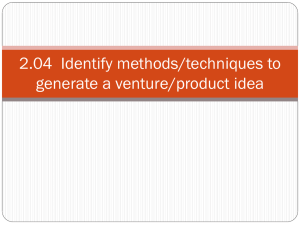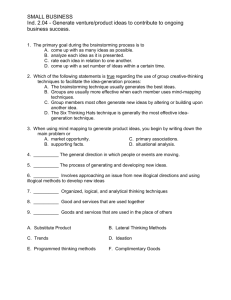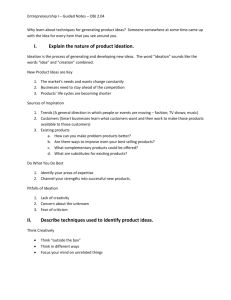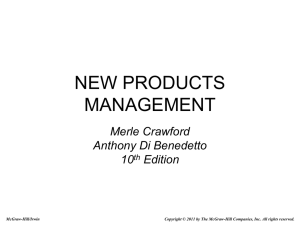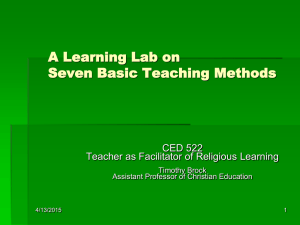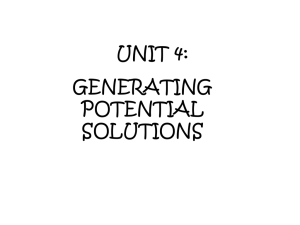Performance Element 3.01
advertisement
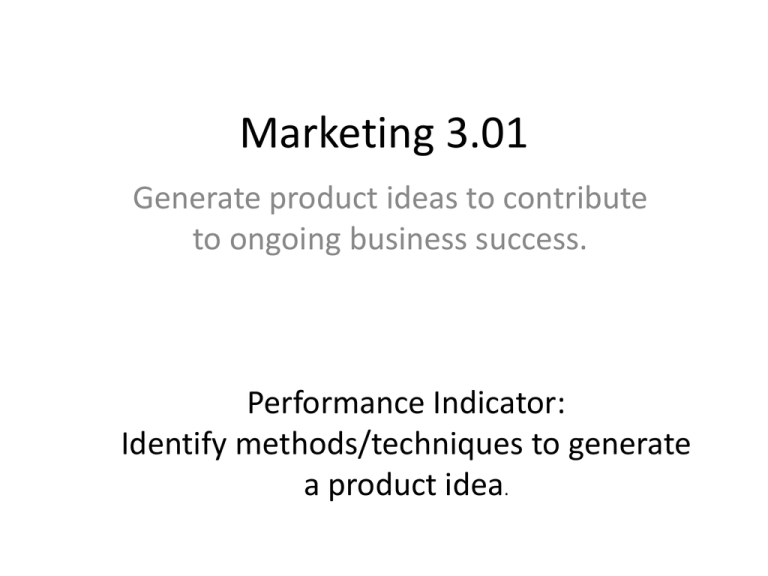
Marketing 3.01 Generate product ideas to contribute to ongoing business success. Performance Indicator: Identify methods/techniques to generate a product idea. Vocabulary • • • • • • • • • • Attribute listing Lateral thinking Analogies Associations Brainstorming Synectics Sketching and doodling Forced questioning Morphological analysis Six thinking hats Definitions on next slides • Attribute Listing: is breaking the problem down into smaller and smaller bits and seeing what you discover when you do. • Lateral Thinking: involves approaching the issue from new illogical directions and using illogical methods to develop new ideas. • Analogies: comparisons between things which have similar features, often used to help explain a principle or idea • Associations: a thought, idea, or feeling that is linked with an event • Brainstorming: identifying as many different ideas as possible during a certain time frame. • Synectics: making connections through the use of forced relations • Sketching and Doodling: techniques for putting ideas on paper very quickly. – Sketching is freehand drawing which follows the rules for technical drawings. It includes techniques for orthographic and pictorial drawing, including isometrics. – Doodling tends to be more freeform, but it can include sketching techniques. • Forced Questioning: uses basic question starters to develop original questions to ask and answer about the product opportunity. • Morphological Analysis: uses the same basic technique, but is used to create a new product by mixing components in a new way • Six Thinking Hats: is a creative-thinking technique that stimulates idea generation by categorizing information. http://www.youtube.com/watch?v=cjVxSk1MqO4 Explain the role of criticism in idea creation • Due to criticism, many business professionals hold back when generating new product ideas. • They do not want to be ridiculed from their co-workers and supervisors. • As a result, there are many missed opportunities for ideas as every idea not spoken or shared is a potential product not realized. Types of Brainstorming Techniques • Relay Brainstorming – As its name implies, it is similar to a relay race. – Multiple individuals from opposing teams respond in a certain order with no assistance from his/her team. • Round Robin Brainstorming – Does not involve teams – Participants respond quickly when it is their turn. • Starbursting – Participants draw a 6 point star with the product written in the middle. – On each tip of the star, write: Who? What? Why? Where? When? How? – These questions help to develop ideas Distinguish among free association techniques, forced relations techniques, and analytical techniques used to generate business/product ideas. – Lateral Thinking • Approaching the issue from new illogical directions and using illogical methods to develop new ideas. • Ex. Free association and forced relation techniques – Programmed Thinking • Techniques are logical and analytical • Structured, organized ways to develop new ideas and products. Sources of Business/Product Ideas • Trends – Fashion, television shows, music – Health and fitness • Video games • Fitness apps for smart phones • Dance workout classes – Age of Population • Baby boomers – largest segment of the population Sources of Business/Product Ideas • Customers – Who better to tell you ideas than the customers who buy your products? – Marketers must be observant; watch their customers; notice problems – Marketers should use formal/informal methods such as focus groups, surveys, comment cards. – Marketers should talk with other professionals who interact with customers regularly. Sources of Business/Product Ideas • Existing Products – Existing complaints about products – Look for ways to improve your goods/services even when there are no problems. • Complementary Products – Those that go along with something else that already exists. • Substitute – A product that takes the place of another product. Importance of evaluating a business owner’s strengths when generating business/product ideas • A business owner knows his/her own company’s strengths. • When generating business/product ideas, think about what the company does best. • How can you turn those strengths into successful products? Pitfalls to idea identification • • • • The fear of the unknown Risks associated with a new product Criticism or ridicule from co-workers/supervisor Not being able to “think outside the box” Importance of generating business/product ideas • Helps determine the long term survival, profitability, and success of a business. • Change in the market is constant; therefore, businesses must respond to or even anticipate those changes. If not, customers look to the competition. • To stay ahead of the competition. • Product life cycles are shorter. Methods/techniques used to identify business/product ideas • • • • Mind Mapping – A visual creative thinking technique. – Generate ideas by making associations. – Expands thinking and generates many ideas in a short amount of time. Braindrawing – Taking turns sketching or doodling – Builds on the other’s drawings – Study the doodles – Determine how the shapes can be related to their product opportunity. Free Association – Allow the mind to wander – Identify the first thing that comes to mind – Record the flow of ideas – Continue the process until a connection Forced Questioning – Similar to starbursting – Basic questions develop into product opportunity questions – Includes more than the 5 W’s – More situational wording such as might, would, could Methods/techniques used to identify business/product ideas • Synectics – – – – Derived from a Greek word meaning “bringing forth together” Making connections through forced relations. Time consuming but rewarding Excellent tool when other methods fail • Forced Relations – Connecting two items or ideas that seem unrelated • Forced associations – Forcing random words into associations about your issue. – Similar to free association; however, makes connection between the random word and the product opportunity – No mind drifting • Forced Analogies – Uses metaphors and similes to create connections. – These connections may seem very different than your situation. Marketing 3.01 Generate product ideas to contribute to ongoing business success. Performance Indicator: Generate product ideas Purposes of idea-generating methods/techniques • Ideation process is how many great product ideas originate. • Ideation is the process of generating and developing new ideas. • New ideas help determine a business’ long term success and profitability. • Customers’ needs/wants are constantly changing. Advantages/disadvantages of ideagenerating methods/techniques • Benefits – Many ideas can be generated in a short time. – Requires few material resources. – The results can be used immediately or "preserved" for possible use in other projects. • Advantages – Is a "democratic" way of generating ideas (assuming a good facilitator). – Is a useful way to get over "design" blocks that are slowing development. – The concept of brainstorming is easy to understand. • Disadvantages – Requires an experienced and sensitive facilitator who understands the social psychology of small groups. – Requires a dedication to quantity rather than quality. – Can be chaotic and intimidating to introverts. – May not be appropriate for some business or international cultures. Role of a facilitator in generating product/business ideas • Who Can Facilitate • The basic brainstorming procedure seems simple enough that anyone could facilitate a session, but the social dynamics of product groups are both complex and subtle so facilitators should have some training on how to: • Motivate participants. • Keep the focus on the topic. • Understand the issues that affect small group interaction. • A facilitator also needs to understand how to organize and analyze the data from brainstorming sessions. • Facilitators must not let participants belabor their points or start telling war stories. This can reduce the quantity of items and act as an inhibitor since the stories often include some subtle guidance or implied criticism. • Facilitators should avoid inviting someone that is generally feared by the group since this is likely to reduce the quantity of ideas. Questions to ask to facilitate idea generation • A great question should be well-timed and carefully formed to test and pinpoint problem areas. • A great question will start the exploration process and facilitate further investigation and study of the problem. • Great questions will uncover facts. • Use questioning words such as "What, What if, Where, Why, When, and How", to develop quality questions. • Ask BOTH open-ended and closed-ended questions. Questions to ask to facilitate idea generation • Clarifying questions – those that help ensure a full understanding of topics; essential for all team members to be working with common knowledge for planning problem solving. • Exploratory questions – emphasize possibilities that have not yet been discussed; enhance teams ability to find creative solutions. • Why questions – these examine the underlying rationale for actions, processes, or circumstances; useful for problem solving, planning and several other purposes. Implement methods/techniques to generate product/business ideas • • • • Focus Groups Brainstorming Problem inventory analysis For implementing, reference the article listed in the following web address. http://www.innovationtools.com/Articles/EnterpriseDetails.asp?a=77
